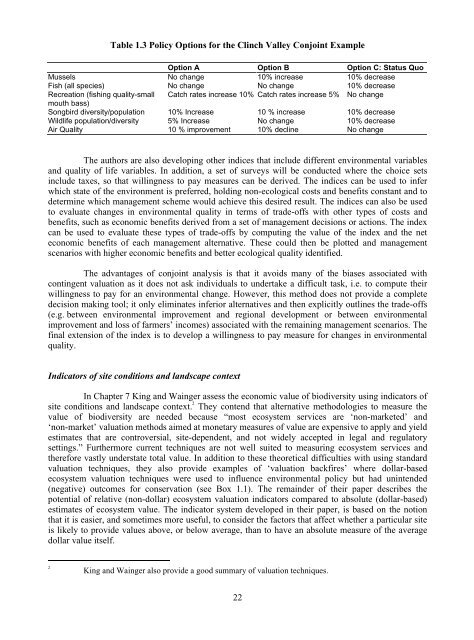Valuation of Biodiversity Benefits (OECD)
Valuation of Biodiversity Benefits (OECD)
Valuation of Biodiversity Benefits (OECD)
- No tags were found...
Create successful ePaper yourself
Turn your PDF publications into a flip-book with our unique Google optimized e-Paper software.
Table 1.3 Policy Options for the Clinch Valley Conjoint ExampleOption A Option B Option C: Status QuoMussels No change 10% increase 10% decreaseFish (all species) No change No change 10% decreaseRecreation (fishing quality-small Catch rates increase 10% Catch rates increase 5% No changemouth bass)Songbird diversity/population 10% Increase 10 % increase 10% decreaseWildlife population/diversity 5% Increase No change 10% decreaseAir Quality 10 % improvement 10% decline No changeThe authors are also developing other indices that include different environmental variablesand quality <strong>of</strong> life variables. In addition, a set <strong>of</strong> surveys will be conducted where the choice setsinclude taxes, so that willingness to pay measures can be derived. The indices can be used to inferwhich state <strong>of</strong> the environment is preferred, holding non-ecological costs and benefits constant and todetermine which management scheme would achieve this desired result. The indices can also be usedto evaluate changes in environmental quality in terms <strong>of</strong> trade-<strong>of</strong>fs with other types <strong>of</strong> costs andbenefits, such as economic benefits derived from a set <strong>of</strong> management decisions or actions. The indexcan be used to evaluate these types <strong>of</strong> trade-<strong>of</strong>fs by computing the value <strong>of</strong> the index and the neteconomic benefits <strong>of</strong> each management alternative. These could then be plotted and managementscenarios with higher economic benefits and better ecological quality identified.The advantages <strong>of</strong> conjoint analysis is that it avoids many <strong>of</strong> the biases associated withcontingent valuation as it does not ask individuals to undertake a difficult task, i.e. to compute theirwillingness to pay for an environmental change. However, this method does not provide a completedecision making tool; it only eliminates inferior alternatives and then explicitly outlines the trade-<strong>of</strong>fs(e.g. between environmental improvement and regional development or between environmentalimprovement and loss <strong>of</strong> farmers’ incomes) associated with the remaining management scenarios. Thefinal extension <strong>of</strong> the index is to develop a willingness to pay measure for changes in environmentalquality.Indicators <strong>of</strong> site conditions and landscape contextIn Chapter 7 King and Wainger assess the economic value <strong>of</strong> biodiversity using indicators <strong>of</strong>site conditions and landscape context. 2They contend that alternative methodologies to measure thevalue <strong>of</strong> biodiversity are needed because “most ecosystem services are ‘non-marketed’ and‘non-market’ valuation methods aimed at monetary measures <strong>of</strong> value are expensive to apply and yieldestimates that are controversial, site-dependent, and not widely accepted in legal and regulatorysettings.” Furthermore current techniques are not well suited to measuring ecosystem services andtherefore vastly understate total value. In addition to these theoretical difficulties with using standardvaluation techniques, they also provide examples <strong>of</strong> ‘valuation backfires’ where dollar-basedecosystem valuation techniques were used to influence environmental policy but had unintended(negative) outcomes for conservation (see Box 1.1). The remainder <strong>of</strong> their paper describes thepotential <strong>of</strong> relative (non-dollar) ecosystem valuation indicators compared to absolute (dollar-based)estimates <strong>of</strong> ecosystem value. The indicator system developed in their paper, is based on the notionthat it is easier, and sometimes more useful, to consider the factors that affect whether a particular siteis likely to provide values above, or below average, than to have an absolute measure <strong>of</strong> the averagedollar value itself.2King and Wainger also provide a good summary <strong>of</strong> valuation techniques.22












